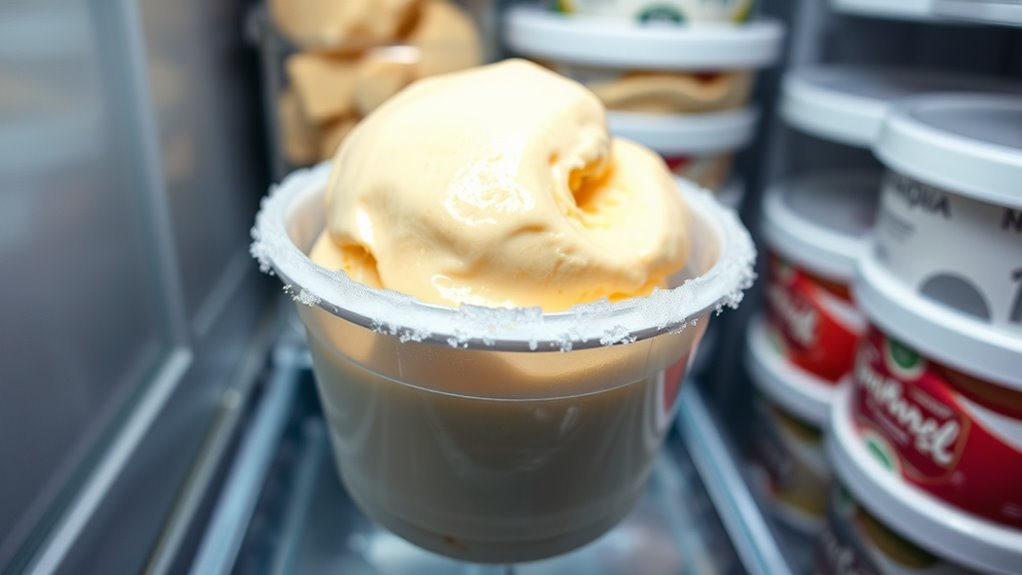To prevent freezer burn, always store ice cream in airtight containers or wrap it tightly with plastic wrap or aluminum foil before freezing. Keep it in the coldest part of your freezer and avoid opening the door often. Use vacuum-sealers when possible to remove excess air, and consume within a few months for best quality. Proper wrapping and storage are key to keeping your ice cream smooth and delicious — learn more to protect every scoop.
Key Takeaways
- Use airtight containers or tightly wrap ice cream with plastic wrap to prevent air exposure.
- Press plastic wrap directly onto the surface to eliminate air pockets before sealing.
- Store ice cream in the coldest part of the freezer and avoid frequent door openings.
- Consume within a few months to minimize ice crystal formation and preserve texture.
- Maintain a steady freezer temperature and consider vacuum-sealing for maximum protection.

Have you ever opened your freezer only to find your food covered in dry, leathery spots? That’s freezer burn, and it happens when moisture escapes from your food, leading to those unappealing ice crystals and texture changes. Luckily, preventing freezer burn is straightforward if you pay attention to how you store your ice cream. The key lies in using airtight containers and practicing proper wrapping techniques. These simple steps can make a big difference in keeping your ice cream creamy and fresh.
Freezer burn happens when moisture escapes, causing ice crystals and texture changes in your ice cream.
When it comes to storing ice cream, the first step is choosing the right container. Airtight containers are your best bet because they seal out air, which is the main culprit behind freezer burn. Glass or plastic containers with tight-fitting lids create a barrier that minimizes moisture loss. If you prefer to keep your ice cream in its original carton, make sure to wrap it tightly with plastic wrap before resealing. This extra layer of protection helps prevent air from seeping in around the edges, reducing the risk of ice crystals forming on the surface.
Proper wrapping is equally important. Before placing your ice cream in the freezer, consider wrapping it in a layer of plastic wrap or aluminum foil. This added barrier acts as a shield against air exposure and helps maintain the ice cream’s texture. Be sure to press the wrap directly onto the surface of the ice cream to eliminate any air pockets. If you’re transferring ice cream to a different container, be meticulous about removing as much air as possible before sealing. Vacuum-sealing is another excellent method if you want to take extra precautions; it removes most of the air and keeps your ice cream fresh for longer. Additionally, understanding proper storage techniques can significantly reduce the risk of freezer burn.
Another helpful tip is to store your ice cream in the coldest part of your freezer, usually near the back or bottom. Fluctuations in temperature can lead to ice crystal formation, so keeping it consistently cold helps preserve its quality. Additionally, avoid opening the freezer door repeatedly or leaving it open for extended periods. Every time the fridge door opens, warm air enters, and the temperature can fluctuate, increasing the chances of freezer burn.
Finally, try to consume your ice cream within a reasonable time frame—ideally within a few months. The longer it sits, the more likely it is to develop ice crystals and freezer burn, despite your best efforts. By combining airtight containers, proper wrapping, and mindful storage, you’ll keep your ice cream irresistibly smooth and delicious, free from those dry, leathery patches that ruin the experience. Keep these tips in mind, and you’ll enjoy every scoop as if it were fresh from the store.
Frequently Asked Questions
How Long Does Ice Cream Typically Stay Fresh in the Freezer?
Ice cream typically stays fresh for about 2 to 4 months in your freezer. To maximize its shelf life, follow proper freezer storage tips, like keeping it tightly sealed and avoiding temperature fluctuations. If you notice ice crystals or freezer burn, it’s a sign to use it up soon. Proper storage helps preserve the flavor and texture, ensuring you enjoy your favorite treat at its best for as long as possible.
Can I Refreeze Partially Melted Ice Cream Safely?
Imagine the joy of savoring your favorite ice cream, only to see it partially melted—can you refreeze it safely? Yes, but be cautious. Refreezing safety depends on how long it’s been out; if it’s been above 40°F for over two hours, bacteria may develop. Expect texture changes, like ice crystals and graininess. To enjoy it safely and maintain the best texture, refreeze promptly and use it soon after.
What Types of Containers Are Best for Preventing Freezer Burn?
You should use airtight containers or silicone lids to prevent freezer burn. Airtight containers keep moisture out, maintaining ice cream’s texture and flavor, while silicone lids create a secure seal, preventing air from causing ice crystals. Both options help preserve freshness, so choose containers that fit well and seal tightly. By doing this, you’ll protect your ice cream from freezer burn and enjoy its creamy goodness longer.
Does Adding a Layer of Plastic Wrap Help Prevent Ice Crystals?
Adding a layer of plastic wrap over your ice cream can help reduce air exposure, which is key in preventing ice crystals. Wrap the surface tightly to create a barrier that limits moisture loss and air contact. This simple step can markedly slow down freezer burn, keeping your ice cream fresher and creamier for longer. Just make sure the plastic wrap is pressed directly onto the surface for the best protection.
How Does Freezer Temperature Affect Ice Crystal Formation?
You should know that freezer temperature plays a vital role in ice crystal formation. When your freezer is too warm, ice crystals form larger, which affects your ice cream’s texture. To keep crystals small, set your freezer to 0°F (-18°C). This temperature slows down crystal growth, keeping your ice cream smooth. Regularly check your freezer’s temperature to prevent unwanted ice crystal formation and enjoy creamy, delicious treats.
Conclusion
By following these simple tips, you can keep your ice cream delicious and free of pesky ice crystals. Some might think that occasional freezer burn is unavoidable, but with proper storage and care, you can prolong your treat’s freshness. Remember, investing a little effort now guarantees every scoop stays creamy and satisfying. Don’t let freezer burn spoil your dessert experience—take control and enjoy your ice cream at its best every time.










